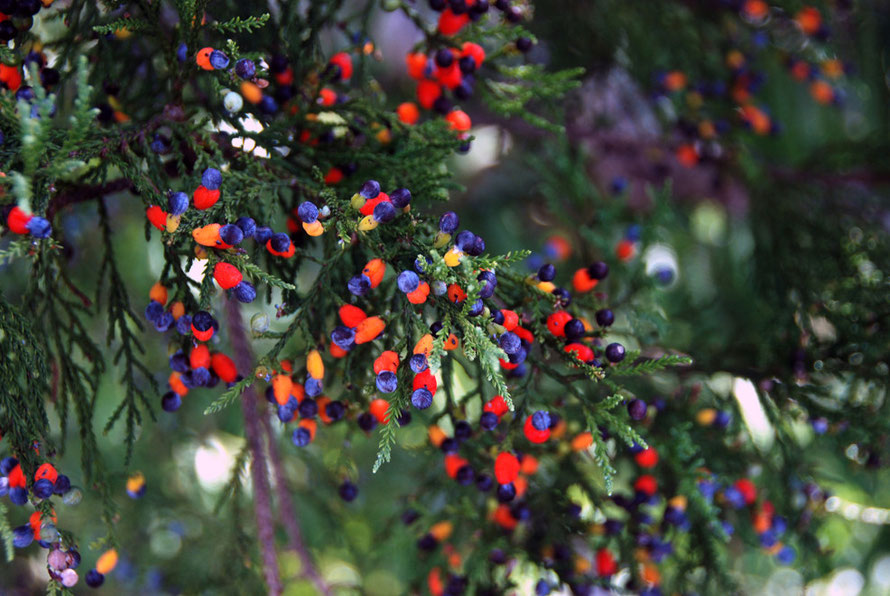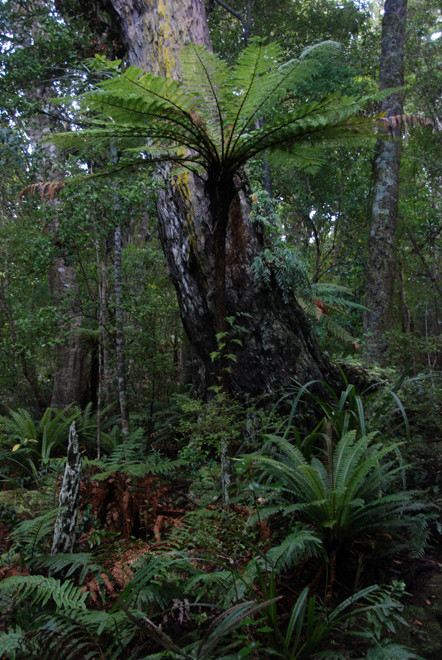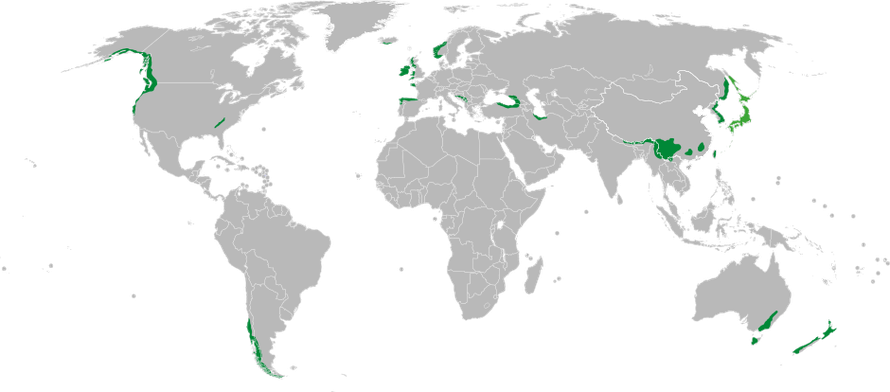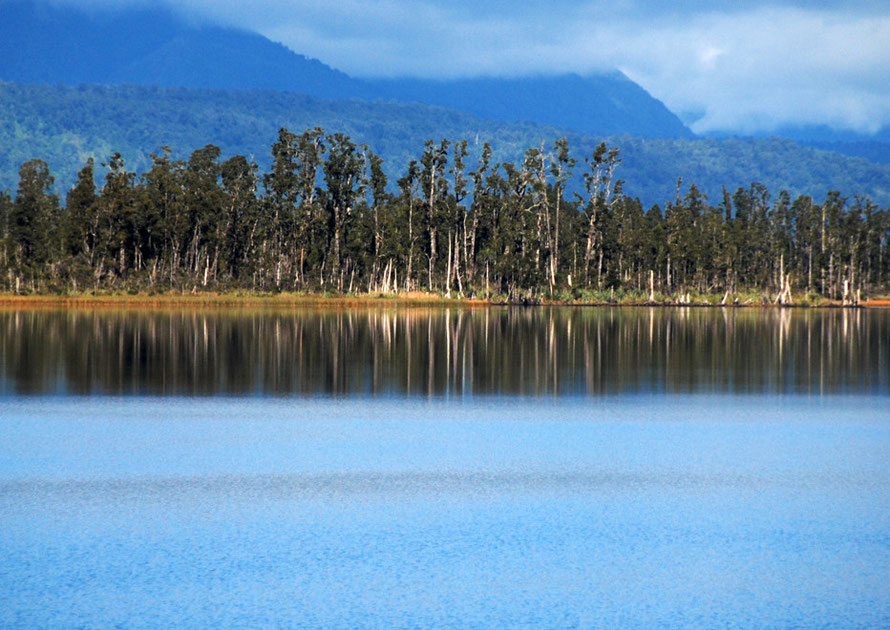An Introduction to New Zealand's Temperate Rain Forests
Introduction
When you look up 'temperate rain forest' (TRF) you realise how much of it there is.One definition of TRFs is Alaback's definition for North American TRF: this is where
- Annual precipitation over 140 cm (55 in)
- Mean annual temperature is between 4 and 12 °C
Definitions elsewhere differ. The Australian definition is ecological-structural rather than climatic:
- Closed canopy of trees excludes at least 70% of the sky;
- Forest is composed mainly of tree species which do not require fire for regeneration, but with seedlings able to regenerate under shade and in natural openings.




The Specificity of the New Zealand Temperate Rain Forests
The uniqueness of New Zealand's temperate rainforest is accounted for by the following factors.
Rainfall
The west coast of New Zealand's South Island is one of the wettest places in the world. Rainfall of up to 14 metres a year is produced by the moist westerlies of the Pacific, Tasman and Southern Oceans running into the Southern Alps which rise abruptly from the coast.
Whatever definition you take the New Zealand Temperate Rain Forests reach an extreme in the amount of rain received. Even in the low parts of the Fox Glacier valley annual rainfall is 3 metres and the highest land receives up to 14 metres. The same goes for Milford Sound and Fiordland.
Latitude
Southern New Zealand sits in mid-southerly latitudes. Temperatures are temperate but not frost free. Typical summer daytime maximum air temperatures range from 17°C to 22°C and seldom exceed 25°C. Winter days often start with frost. Typical winter daytime maximum air temperatures range from 10°C to 14°C (NIWA).
Soils
Soils are developed from decaying glacial and water eroded screes, moraine and outwash plains. Nutrients not held within the biomass of the forest, its understory and forest floor biota are soon leached out of the porous thin soils.
A cycle of nutrient depletion on new made soils occurs (see my Glacial Colonisers page) that enables a specific plant progression from early colonisers to late survivors and hoarders of nutrients.
Although poor soils are young and subject to a cycle of renewal through the rapidity of erosion processes and the production of millions of tons annually of new boulders, gravel, sand, dust and 'glacial milk'.
Altitude
Altitude is the most significant variable. Western lowland forest made up of podocarps is restricted to country below 400m typically on alluvial plains and moraines. Rimu has an upper limit of 600m. Simple montane forest of either kamahi/rata or silver beech extends above the lowland forest to the treeline at 800-1000m.
And as altitude increases temperatures fall and rainfall and eventually snowfall increases as tussock grasses and alpine vegetation take over above the tree line at 900 metres.
Variety of terrain
The young, constantly evolving glacial terrain of the Southern Alps with continued uplift from tectonic forces creates a diversity of terrains. These range from coastal dune belts and back-dune marshes through dry and wet outwash plains fed and frequently altered by roaring, braided rivers to morainic habitats in valley bottoms to the steep, sometimes vertical slopes of the valley sides subject to slips and tree-falls.
On the rainshadow side of the Southern Alpine divide precipitation tails away dramatically creating a new set of habitats that favour trees and shrubs able to tolerate more heat and less water.
Rates of erosion are much slower in the Fiordland mountains than the Southern Alps due to harder rocks, less glacial activity and the more continuous vegetation cover. This results in less soil
regeneration than in the Southern Alps.
Vegetation
Species Age: The lowland western rain forests contain podocarps that are ancient tree species dating back to the Meseozic 200 million years ago on the Gondwanaland super-continent. Fossil records of Rimu pollen identical to today's trees go back 40 millions years. The southern hemisphere beeches - very different from the Northern Hemisphere ones - are amongst the oldest flowering plants and fossil records go back 100-135 million years.
Forest-type diversity - There is great diversity in forest-type from the Kahikatea swamp forests, to the lowland/montane hardwoods of rata and kamahi, the high montane forests of
silver beech dominant on valley slopes and walls to the scattered red beach forests on more fertile upland valley floors and rimu on the depleted morainic soils.
Podocarps - The podocarp forests of Rimu and Kahikatea are the standout features of Westland. Seven other podocarps occur - Miro, Halls/Mountain Totara, Matai, Yellow Silver Pine, Yellow Pine and Pink Pine.
Beech - The beech forests of the mountain slopes are vast. Silver beech is the most common by far while mountain beech are found in the drier areas east of the divide. Red beech are restricted to the warmer and more fertile southern valley floors and hard beech are found but in a few scattered locations.
Distribution
There are significant anomalies in the distribution of temperate rain forest trees, in particular to so-called 'beech gaps' on the West Coast. These appear to originate from the retreat and
advance of species associated with the successive Ice Ages and their success or not in colonising the newly created landscapes.
Hardwoods and shrubs - The lowland forests possess a vast assemblage of plants - kamahi and rata being the most common with toro, hinau, quintinia. Typical hardwood shrubs include broadleaf, pokaka, mahoe, pate, wineberry, tree fuscia and pigeonwood. Tree ferns older than the podocarps abound. The understory has a host of epiphytes, ferns, mosses, liverworts, orchids and lichens.
Plant diversity - The forests support a rich flora for their latitude. At Waitutu on the southern coast of the South Island over 220 species of higher forest plant have been recorded.
(See Smith, K. 'Rainforests of the South West' for a very useful summary in Royal Forest and Bird Protection Society Forest, Fiords and Glaciers 1987 p.49-56.)
Temperate Rain Forest Tour
I had originally intended to have a separate section of pages exploring the the temperate rain forests of the South Island of New Zealand. I have now integrated these different pages into their relevant geographical sections.
I have put links on the pages below starting with the Fox Glacier Rain Forests so that it is possible to
follow a tour through these pages. Just click on the Temperate Rain Forest Tour link at the end of each page. Click here to start.
Southern Alps and Glaciers - the Fox Glacier Rain Forests and the Kahikatea Swamp Forests of the outwash plains.
Stewart Island - Ulva Island
Milford - the Milford Rain Forests
This will also include a page on the Kauri forests in the North Island.

